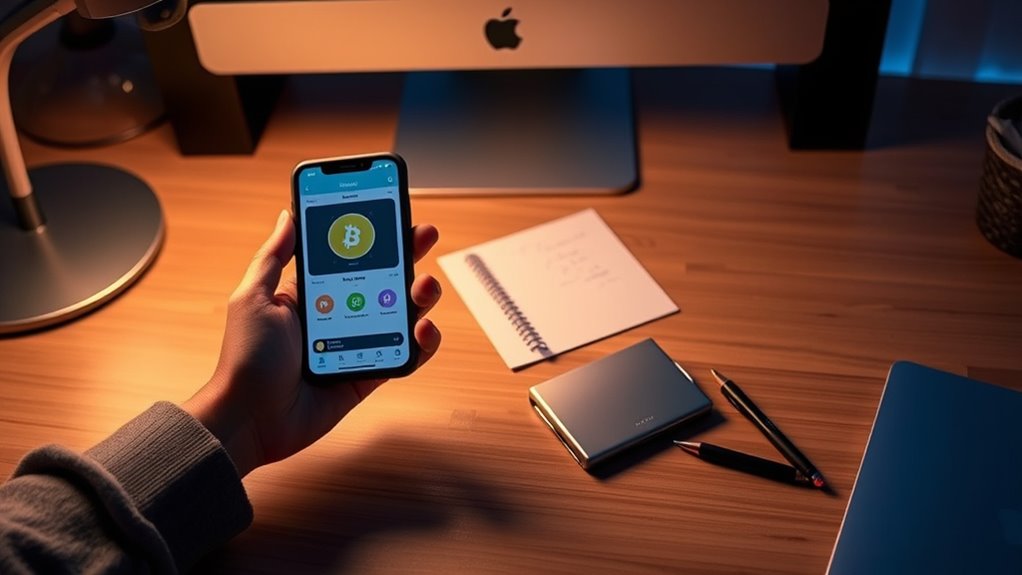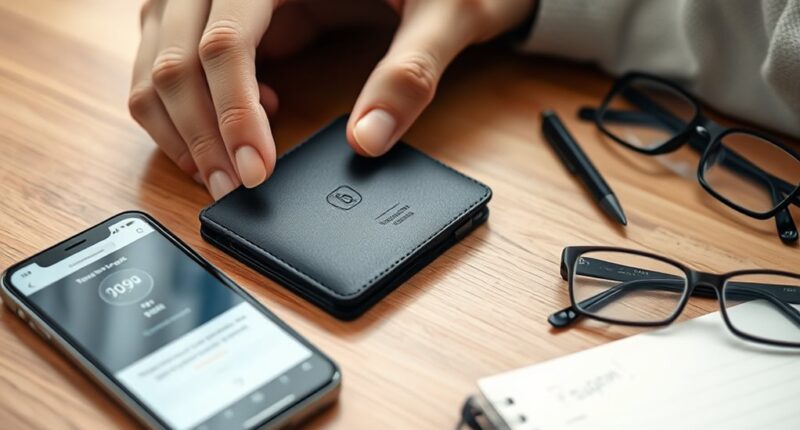To set up a self-custody crypto wallet, you’ll need to choose a hardware wallet and initialize it by generating a new private key. During setup, you’ll receive a recovery seed, which you must keep offline and secure—never share it or store it digitally. Keep your device’s firmware updated and store the seed in a safe place, as it’s the key to restoring your assets. Want to learn more about keeping your assets safe?
Key Takeaways
- Choose a reputable hardware wallet and purchase it from official sources.
- Initialize the device to generate a new private key and receive your recovery seed.
- Write down the recovery seed securely offline and never share it online.
- Connect the hardware wallet to your computer or mobile device to set up and configure your wallet.
- Regularly update firmware, keep the seed offline, and practice good security habits to protect your assets.

A self-custody crypto wallet puts you in complete control of your digital assets, freeing you from reliance on third-party services. When setting up your wallet, one of the most critical aspects to master is private key management. Your private key is the gateway to your funds; if it’s lost or compromised, your assets are at risk. That’s why safeguarding your private keys should be your top priority. Many beginners overlook this step, thinking the wallet provider handles security, but with self-custody, you’re responsible for keeping your keys safe. To do this effectively, you should consider using a hardware wallet, which offers enhanced security compared to software wallets. Hardware wallets store your private keys offline, making them less vulnerable to hacking attempts and malware. They’re physical devices—like USB sticks—that generate and store your private keys securely, isolated from internet threats.
Setting up a hardware wallet involves initializing the device, which typically includes generating a new private key securely within the device itself. During this process, you’ll be given a recovery seed—usually a series of 12, 18, or 24 words—that acts as a backup for your private key. It’s crucial to keep this recovery seed offline and in a safe place, as anyone with access to it can control your assets. Never share this seed, and avoid storing it digitally or online, where it could be vulnerable to theft or hacking. Once your hardware wallet is initialized and your recovery seed is securely stored, you can connect it to your computer or smartphone and set up your wallet interface. This setup allows you to send and receive cryptocurrencies securely, with the confidence that your private keys remain protected within the device’s hardware.
Proper private key management is essential for maintaining the security of your assets, especially when managing large amounts of crypto. Hardware wallet security provides peace of mind, especially when managing large amounts of crypto. It minimizes risks associated with malware, phishing, or hacking since the private keys never leave the device. You retain full control over your private keys, and by managing them properly, you ensure your assets stay safe. Remember, the security of your self-custody wallet depends heavily on your habits—regularly updating device firmware, keeping your recovery seed confidential, and avoiding suspicious links or downloads. By doing so, you establish a robust defense against theft or loss. Setting up a self-custody crypto wallet might seem complex at first, but with a focus on private key management and hardware wallet security, you gain complete sovereignty over your digital assets, making your crypto journey safer and more autonomous.
Frequently Asked Questions
What Are the Common Mistakes to Avoid When Setting up a Wallet?
You should avoid common mistakes like neglecting seed phrase management and ignoring wallet security best practices. Never share your seed phrase or store it insecurely, as this risks losing access or theft. Always use strong, unique passwords and enable two-factor authentication if available. Double-check that you’re downloading the official wallet app, and keep backups secure. Staying vigilant helps protect your assets and ensures your wallet remains safe.
How Do I Recover My Wallet if I Lose My Private Keys?
If you lose your private keys, don’t panic. You’ll need to rely on your backup seed phrase or recovery process, which is essential for private key management. Find your securely stored seed phrase, enter it into your wallet’s recovery option, and follow the prompts. This restores access to your wallet and funds. Always keep your seed phrase offline and private to prevent unauthorized access.
What Hardware Wallets Are Recommended for Beginners?
Oh, you want to plunge into hardware wallets without turning into a tech whiz overnight? For beginners, Ledger Nano S or Trezor Model One are your best bets. They offer straightforward hardware wallet comparison and beginner wallet features like easy setup and clear instructions. These options keep your crypto safe without requiring a PhD in cybersecurity. Grab one, follow the simple guide, and you’re ready to securely manage your crypto stash.
Can I Use a Self-Custody Wallet on Multiple Devices Securely?
Yes, you can use a self-custody wallet on multiple devices securely. To guarantee device synchronization and multi-device security, use a strong, unique seed phrase and avoid sharing it. Enable two-factor authentication if available, and keep each device’s software up to date. Be cautious about connecting to public Wi-Fi or installing untrusted apps, as these can compromise your wallet’s security across all devices.
How Do I Securely Back up My Wallet’s Seed Phrase?
To securely back up your seed phrase, store it in a safe, offline location like a physical safe or a secure offline storage device. Use robust backup methods such as writing it down on paper or engraving it on metal. Avoid digital storage to prevent hacking risks. Keep multiple copies in different secure places, and never share your seed phrase with anyone. This guarantees your seed phrase remains private and protected from theft or loss.
Conclusion
Now that you know how to set up your self-custody crypto wallet, you’re ready to securely store your savings. Remember, responsibility and research are your best friends on this journey. Take your time, stay vigilant, and safeguard your stash with smart security steps. Self-custody isn’t just a task; it’s a trust, a triumph, and a terrific way to take control. So, step confidently, secure your stash, and savor your crypto freedom!









